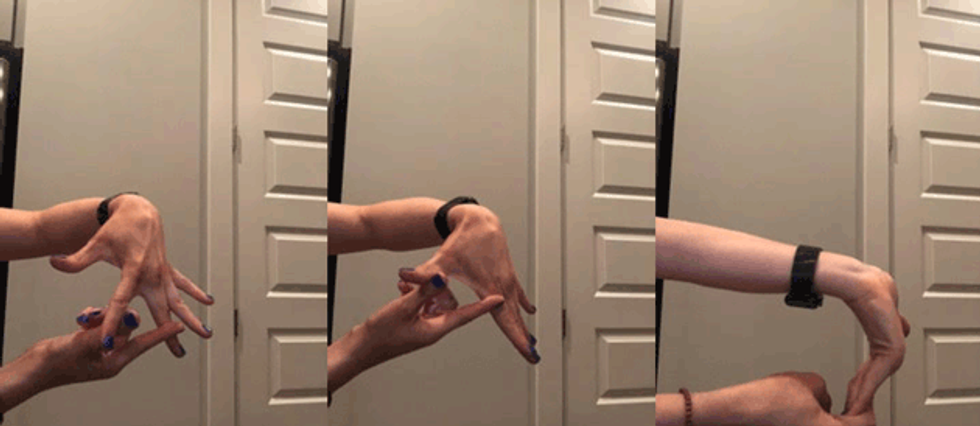Theory: Beginner
Lesson Overview:
• Develop a systematic approach to practicing.
• Improve your alternate picking and string skipping.
• Strengthen your internal sense of time. Click here to download a printable PDF of this lesson's notation.
I get asked a lot about what kind of warm-up routines I do on the road before a show, or how much time I practice every day. On an off day at home, I love being able to put in hours of practice, but with our schedule these days, sometimes we're traveling seven or more hours on planes every day of the week. By the time we land in a city … well, there goes my practicing time.
However, I do have a core group of daily exercises and I always include a warm-up before I walk onstage. On days when I'm playing a 75-minute show, I don't “work" my hands as hard as I would on an off day. I view an off day, or a day that I have scheduled to practice, like a workout at the gym. In this lesson, I wanted to lay out a maintenance workout for you. The number of sets or repetitions are optional depending on your playing, but working out the muscles in your hands is just as important as working out your quadriceps or biceps…. so here we go!
Get Your Stretch On
Stepping on a small soapbox here.
I hate stretching pretty much at any time in life—whether I'm going for a run or I'm getting ready to play a show. However, stretching is important and playing guitar puts a lot of stress on your wrists, fingers, and hands. So, don't forget to stretch! Below are a few pics of some stretches I like to do before and after I practice.
Steps off the soapbox.
Chromatic Runs
Let's dig into Ex. 1. Although it doesn't roll through the entire chromatic scale, it has enough of a chromatic bent for our purposes. Here I'll use a strict alternate-picking technique starting with a downstroke on the 6th string at the 1st fret. Keep this 1-2-3-4 pattern going across the fretboard until you get to the 4th fret on the 1st string. You will then move up one fret and start a 4-3-2-1 descent back across the strings. Progressively work your way up to the 15th fret, and then go back down until you return to the 1st fret.
Assignment: 4 sets of 12 reps.
Challenge: Once you master the 1-2-3-4 pattern, switch it up to 1-3-2-4, 2-4-1-3, or whatever combination you want to try to challenge your brain with!
Click here for Ex. 1
Spiderwebs
Next, we'll take a more diagonal approach for Ex. 2. First, line up your fingers in a diagonal pattern with your first finger on the 6th string at the 1st fret and your fourth finger on the 3rd string at the 4th fret. We still want to use a strict alternate-picking pattern here. After you descend back across the strings, move your first finger up to the 2nd fret and repeat the pattern moving up the neck. Once you've reached the 12th fret with your first finger, you've finished your first set!
Assignment: 6 sets of 12 reps.
1st set: Up the neck on the 6th string.
2nd set: Down the neck on the 5th string.
3rd set: Up the neck on the 4th string.
4th set: Down the neck on the 4th string.
5th set: Up the neck on the 5th string.
6th set: Down the neck on the 6th string.
Click here for Ex. 2
Learn the Notes
When I started to play guitar, I took formal lessons for a few years. I can thank Corey, one of my first teachers, for this exercise. It's so important to know every note on the neck of your guitar. It helps you when you're playing different inversions of chords up the fretboard, and it's also a lifesaver when you're in the middle of a solo jumping around to different positions.
In this exercise (Ex. 3), we'll be playing a scale with one note on every string. For our purposes, we'll use a C major (C–D–E–F–G–A–B) scale. Keep going playing one note on each string until you end up playing C on the 6th string. You'll notice we're jumping octaves in this exercise. That's fine—it's the note names we're after, in every available octave.
We'll start this slow at 60 bpm, but with practice you'll get much faster at it, so increase your speed as you find your notes more quickly. Also, when you make a mistake, you have to start from the beginning!
Assignment: 1 set. (1 long rep!)
Challenge: Try this approach with Mixolydian and Dorian scales. In all keys.
Click here for Ex. 3
Pickin' Like Petrucci
There are a wealth of great warm-up exercises in John Petrucci's legendary Rock Discipline video. Ex. 4 is one of my favorites that I snagged from Petrucci. Feel free to mod it to create something that will challenge you. Here, we start with a simple F major triad (F–A–C) in 1st position. It's a six-measure pattern after you repeat the top note and then descend. That's one rep. Slide up a fret and repeat the whole pattern again.
Assignment: 6 sets of 12 reps.
1st set: Pick each note once.
2nd set: Pick each note twice.
3rd set: Pick each note three times.
4th set: Pick each note four times.
5th set: Pick each note five times.
6th set: Pick each note six times.
Challenge: Try using hybrid picking.
Click here for Ex. 4
Pentatonics
I love incorporating exercises that use pentatonic scales because they are way more applicable to playing live than other more chromatic exercises. In Ex. 5, you'll take each of your five pentatonic shapes and break them up into groups of three notes. (We're kicking things off with F minor pentatonic in the 1st position.) Start on the highest note in each position, descend three notes, go back to the second highest note, descend, and repeat. When you finish one pattern, that's your first rep. Slide up to the next pattern (here, F# minor pentatonic) and start again.
Assignment: 2 sets of 5 reps.
1st set: Three-note groups in all five patterns.
2nd set: Four-note groups in all five patterns.
Click here for Ex. 5
Bend It!
A simple exercise, Ex. 6 is really good for training your ear to nail those bends. You can really use any lick that incorporates your favorite bend, but for the purposes of this exercise I'll keep it simple. Here, I'm working up the neck using whole-step bends and not really paying attention to sticking within a specific key. Work your way all the way up the neck to the 12th fret and that's your first set!
Assignment: 3 sets of 12 reps.
Click here for Ex. 6
It's Hammer Time!
This exercise really helps strengthen my hands (Ex. 7). It's all about developing a more consistent tone between your picked notes and those that come from hammer-ons or pull-offs. Stay in the same position and continue the pattern 20 times—that's your first set. Slide up one fret and start your second set. This is going to feel slow at first, but get each note sounding perfect and increase your speed.
Assignment: 5 sets of 20 reps.
Click here for Ex. 7
Time to Play!
As your last “exercise," choose a solo you know, or a song you've always wanted to learn, and practice it. Break it down into little sections and make sure you know it.
Bonus Round
This could work with any of the above exercises, but I tend to do this with Ex. 1 or Ex. 2 to test my ability to keep up with and without a metronome.
Challenge #1
Thanks to Premier Guitar's own Jason Shadrick, I have been using an app called Time Guru. It allows you to set a percentage of time where the metronome will just randomly drop out. For instance, if you set it to 30 percent, it will randomly drop 30 percent of the beats and it's up to you to come back in with the click.
Challenge #2
I saw Victor Wooten do this once and it blew my mind. Start with your metronome around 120 bpm and play a simple scale. Then decrease to 60 bpm and finally 30 bpm all while playing the scale at the same tempo. At 30 bpm you will only have one metronome click for every four notes.
Either of these challenges are great ways to test your sense of time, and really good brain exercises to make sure you don't get too dependent on that metronome.
Cool Down
Stretching. Same as above. Won't get on my soapbox this time, but remember, it's important to prevent yourself from injury.
Alright, you're done! This is just one example of a typical workout I would do on an off day. Before I play a show, I might do a few sets of these exercises, depending on how much time I have.
I love hearing your comments and any feedback. Hit me up on Instagram at @lindsayell.














![Rig Rundown: Russian Circles’ Mike Sullivan [2025]](https://www.premierguitar.com/media-library/youtube.jpg?id=62303631&width=1245&height=700&quality=70&coordinates=0%2C0%2C0%2C0)













